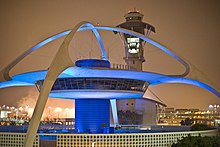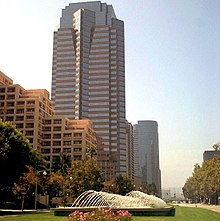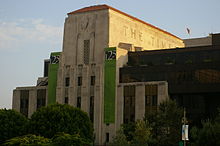Freeways and highways
The city and the rest of the Los Angeles metropolitan area is served by an extensive network of freeways and highways. The Texas Transportation Institute, which publishes an annual Urban Mobility Report, ranked Los Angeles road traffic as the most congested in the United States in 2005 as measured by annual delay per traveler. The average traveler in Los Angeles experienced 72 hours of traffic delay per year according to the study. Los Angeles was followed by San Francisco/Oakland, Washington, D.C. and Atlanta, (each with 60 hours of delay). Despite the congestion in the city, the mean travel time for commuters in Los Angeles is shorter than other major cities, including New York City, Philadelphia and Chicago. Los Angeles' mean travel time for work commutes in 2006 was 29.2 minutes, similar to those of San Francisco and Washington, D.C.
Among the major highways that connect LA to the rest of the nation include Interstate 5, which runs south through San Diego to Tijuana in Mexico and then north to the Canadian border through Sacramento,Portland, and Seattle; Interstate 10, the southernmost east–west, coast-to-coast Interstate Highway in the United States, going to Jacksonville, Florida; and U.S. Route 101, which heads to the California Central Coast, San Francisco, the Redwood Empire, and the Oregon and Washington coasts.
Public transportation

Current Los Angeles Metro Rail map showing existing and under-construction lines.
The Los Angeles County Metropolitan Transportation Authority and other agencies operate an extensive system of bus lines, as well as subway and light rail lines across Los Angeles County, with a combined daily ridership of 1.7 million. The majority of this (1.4 million) is taken up by the city's bus system, the second busiest in the country. The subway and light rail combined average the remaining roughly 319,000 boardings per weekday. In 2005, 10.2% of Los Angeles commuters rode some form of public transportation.
The city's subway system is the ninth busiest in the United States and its light rail system is the country's third busiest. The rail system includes the Red and Purple subway lines, as well as the Gold, Blue, and Green light rail lines. The Metro Orange Line is a bus rapid transit line with stops and frequency similar those of a light rail. The city is also central to the commuter rail system Metrolink, which links Los Angeles to all neighboring counties as well as many suburbs.
Besides the rail service provided by Metrolink and the Los Angeles County Metropolitan Transportation Authority, Los Angeles is served by inter-city passenger trains from Amtrak. The main rail station in the city is Union Station just north of Downtown.
Air transportation

LAX, the fifth busiest airport in the world
The main Los Angeles airport is Los Angeles International Airport (IATA: LAX, ICAO: KLAX). The sixth busiest commercial airport in the world and the third busiest in the United States, LAX handled over 61 million passengers and 2 million tons of cargo in 2006. The Theme Building is pictured here. LAX is a hub for United Airlines
Other major nearby commercial airports include:
- (IATA: ONT, ICAO: KONT) LA/Ontario International Airport, owned by the city of Los Angeles; serves the Inland Empire.
- (IATA: BUR, ICAO: KBUR) Bob Hope Airport, formerly known as Burbank Airport; serves the San Fernando and San Gabriel Valleys
- (IATA: LGB, ICAO: KLGB) Long Beach Airport, serves the Long Beach/Harbor area
- (IATA: SNA, ICAO: KSNA) John Wayne Airport of Orange County.
- (IATA: PMD, ICAO: KPMD) LA/Palmdale Regional Airport is owned by the city of Los Angeles and serves the northern outlying communities of the Santa Clarita and Antelope Valleys.
The world's third busiest general-aviation airport is also located in Los Angeles, Van Nuys Airport (IATA: VNY, ICAO: KVNY).
Ports

A view of the Vincent Thomas Bridgereaching Terminal Island
The Port of Los Angeles is located in San Pedro Bay in the San Pedro neighborhood, approximately 20 miles (32 km) south of Downtown. Also called Los Angeles Harbor and WORLDPORT LA, the port complex occupies 7,500 acres (30 km2) of land and water along 43 miles (69 km) of waterfront. It adjoins the separate Port of Long Beach.
The sea ports of the Port of Los Angeles and Port of Long Beach together make up the Los Angeles/Long Beach Harbor.Both ports is the 5th busiest container port in the World, with a trade volume of over 14.2 million TEU's in 2008. Singly, the Port of Los Angeles is the busiest container port in the United States and the largest cruise ship center on the West Coast of the United States – Port's World Cruise Center serves about 800,000 passengers in 2009.
There are also smaller, non-industrial harbors along LA's coastline. Safety is provided at the only beach controlled by Los Angeles City by the highly trained Los Angeles City Lifeguards.
The port includes four bridges: the Vincent Thomas Bridge, Henry Ford Bridge, Gerald Desmond Bridge, and Commodore Schuyler F. Heim Bridge.
Passenger ferry service from San Pedro to the city of Avalon on Santa Catalina Island is provided by Catalina Express.













